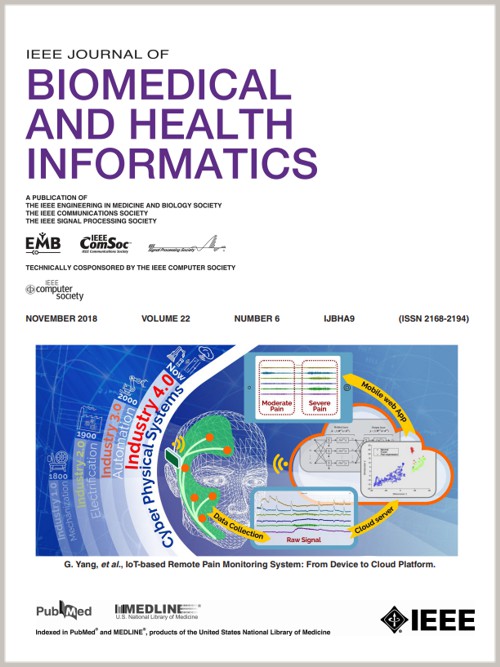ADR-DQPU:使用深度强化和正向无标注学习的新型 ADR 信号检测。
IF 6.7
2区 医学
Q1 COMPUTER SCIENCE, INFORMATION SYSTEMS
IEEE Journal of Biomedical and Health Informatics
Pub Date : 2024-11-05
DOI:10.1109/JBHI.2024.3492005
引用次数: 0
摘要
医学界一直在努力应对来自自发报告系统(SRS)(如美国食品及药物管理局不良事件报告系统(FAERS))的严重和未知药物不良反应(ADRs)的分析和早期检测挑战,因为这些系统往往缺乏专业验证,而且存在固有的不确定性。这些局限性加剧了训练一个强大的机器学习模型来检测来自 SRS 的 ADR 信号的难度。一种解决方案是使用一些权威的 ADR 知识库,如 SIDER 和 BioSNAP,这些知识库包含有限的已证实 ADR 关系(阳性),因此与大量未知数据(未标记)相比,训练集相对较小。本文提出了一种新型 ADR 信号检测方法 ADR-DQPU,通过整合深度强化 Q-learning 和正向无标记学习来缓解上述问题。通过使用 FAERS 数据进行验证,我们的模型优于六种传统方法,总体准确率提高了 26.45%,平均准确率提高了 52.15%,精确度提高了 1.89%,召回率提高了 18.57%,F1 分数提高了 10.95%。与两种最先进的机器学习方法相比,我们的方法总体准确率提高了 64.1%,平均准确率提高了 28.23%,精确度略微降低了 1.91%,召回率提高了 55.56%,F1 分数提高了 45.53%。本文章由计算机程序翻译,如有差异,请以英文原文为准。
ADR-DQPU: A Novel ADR Signal Detection Using Deep Reinforcement and Positive-Unlabeled Learning
The medical community has grappled with the challenge of analysis and early detection of severe and unknown adverse drug reactions (ADRs) from Spontaneous Reporting Systems (SRSs) like the FDA Adverse Event Reporting System (FAERS), which often lack professional verification and have inherent uncertainties. These limitations have exacerbated the difficulty of training a robust machine-learning model for detecting ADR signals from SRSs. A solution is to use some authoritative knowledge bases of ADRs, such as SIDER and BioSNAP, which contain limited confirmed ADR relationships (positive), resulting in a relatively small training set compared to the substantial amount of unknown data (unlabeled). This paper proposes a novel ADR signal detection method, ADR-DQPU, to alleviate the issues above by integrating deep reinforcement Q-learning and positive-unlabeled learning. Upon validation using FAERS data, our model outperformed six traditional methods, exhibiting an overall accuracy improvement of 26.45%, an average accuracy improvement of 52.15%, a precision enhancement of 1.89%, a recall improvement of 18.57%, and an F1 score improvement of 10.95%. In comparison to two state-of-the-art machine learning methods, our approach demonstrated an overall accuracy improvement of 64.1%, an average accuracy improvement of 28.23%, a slight decrease of 1.91% in precision, a recall improvement of 55.56%, and an F1 score improvement of 45.53%.
求助全文
通过发布文献求助,成功后即可免费获取论文全文。
去求助
来源期刊

IEEE Journal of Biomedical and Health Informatics
COMPUTER SCIENCE, INFORMATION SYSTEMS-COMPUTER SCIENCE, INTERDISCIPLINARY APPLICATIONS
CiteScore
13.60
自引率
6.50%
发文量
1151
期刊介绍:
IEEE Journal of Biomedical and Health Informatics publishes original papers presenting recent advances where information and communication technologies intersect with health, healthcare, life sciences, and biomedicine. Topics include acquisition, transmission, storage, retrieval, management, and analysis of biomedical and health information. The journal covers applications of information technologies in healthcare, patient monitoring, preventive care, early disease diagnosis, therapy discovery, and personalized treatment protocols. It explores electronic medical and health records, clinical information systems, decision support systems, medical and biological imaging informatics, wearable systems, body area/sensor networks, and more. Integration-related topics like interoperability, evidence-based medicine, and secure patient data are also addressed.
 求助内容:
求助内容: 应助结果提醒方式:
应助结果提醒方式:


